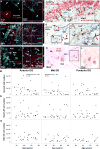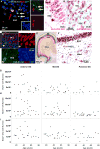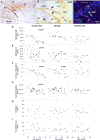Human Hippocampal Neurogenesis Persists throughout Aging - PubMed (original) (raw)
. 2018 Apr 5;22(4):589-599.e5.
doi: 10.1016/j.stem.2018.03.015.
Camille A Fulmore 2, Alexandria N Tartt 2, Laika R Simeon 2, Ina Pavlova 3, Verica Poposka 4, Gorazd B Rosoklija 5, Aleksandar Stankov 4, Victoria Arango 6, Andrew J Dwork 7, René Hen 8, J John Mann 6
Affiliations
- PMID: 29625071
- PMCID: PMC5957089
- DOI: 10.1016/j.stem.2018.03.015
Human Hippocampal Neurogenesis Persists throughout Aging
Maura Boldrini et al. Cell Stem Cell. 2018.
Abstract
Adult hippocampal neurogenesis declines in aging rodents and primates. Aging humans are thought to exhibit waning neurogenesis and exercise-induced angiogenesis, with a resulting volumetric decrease in the neurogenic hippocampal dentate gyrus (DG) region, although concurrent changes in these parameters are not well studied. Here we assessed whole autopsy hippocampi from healthy human individuals ranging from 14 to 79 years of age. We found similar numbers of intermediate neural progenitors and thousands of immature neurons in the DG, comparable numbers of glia and mature granule neurons, and equivalent DG volume across ages. Nevertheless, older individuals have less angiogenesis and neuroplasticity and a smaller quiescent progenitor pool in anterior-mid DG, with no changes in posterior DG. Thus, healthy older subjects without cognitive impairment, neuropsychiatric disease, or treatment display preserved neurogenesis. It is possible that ongoing hippocampal neurogenesis sustains human-specific cognitive function throughout life and that declines may be linked to compromised cognitive-emotional resilience.
Keywords: Ki-67; NeuN; PSA-NCAM; Sox2; dentate gyrus; doublecortin; granule cells; nestin; neural progenitor; volume.
Copyright © 2018 Elsevier Inc. All rights reserved.
Figures
Figure 1. Fewer Quiescent Neural Progenitors and Stable Proliferating Intermediate Neural Progenitors in Aging Human Dentate Gyrus
(A and B) Co-expression of sex determining region Y-box 2 (Sox2) and nestin in QNPs; 4’,6-diamidino-2-phenylindole (DAPI) stained nuclei. (C) Sox2+ type I QNPs in the subgranular zone (SGZ) with apical processes crossing the granule cell layer (GCL) into the molecular layer (ML). (D) Sox2+ type II INPs in SGZ. (E) Glial fibrillary acid (GFAP)+ QNPs with apical process (white arrow) and hilar astrocytes and nestin+ INP (yellow arrow). (F) Nestin/Ki-67+ INP. (G and H) Nestin+ INPs (black arrows) and capillaries (red arrows); INP processes touch remodeling capillaries of tubular morphology. (I and J) Nestin/Ki-67+ INPs (yellows arrows) and capillary (green arrow). (K and L) Ki-67+ cells in SGZ/GCL and differential interference contrast image of Ki-67+ nuclei. (M) Sox2+ cell decline in anterior-mid DG with aging. (N and O) Nestin+ and Ki-67+ cells do not decline with older age in anterior, mid, or posterior DG.
Figure 2. Fewer Polysialylated-Neural-Cell-Adhesion-Molecule-Positive Cells in Aging Human Dentate Gyrus
(A) PSA-NCAM+ cells in subgranular zone (SGZ) and granule cell layer (GCL) with processes projecting into the molecular layer (ML). (B and C) PSA-NCAM+ cells of immature, unipolar, and pyramidal morphology. (D–F) Fewer PSA-NCAM+ cells with aging in anterior DG. (G) Immature, unipolar, and pyramidal cell soma volume is stable with aging.
Figure 3. Preserved Immature and Mature Neurons and Glia in Aging Human Dentate Gyrus
(A) Polysialylated neural cell adhesion molecule (PSA-NCAM) and doublecortin (DCX) expression in an immature neuron between subgranular zone (SGZ) and granule cell layer (GCL), two PSA-NCAM+/DCX− cells, and 4’,6-diamidino-2-phenylindole (DAPI)+ nuclei. (B and C) DCX+ cells in SGZ, without and with stained processes. (D) PSA-NCAM/NeuN+ cell with apical dendrite crossing the GCL. (E) NeuN+ neurons in the granule cell layer (GCL), the molecular layer (ML), and subgranular zone (SGZ) are outlined; these outlines were used to calculate DG and GCL-SGZ volumes. (F) NeuN+ neurons and Nissl+ glia in GCL and hilus. (G–I) Stable DCX+ immature neurons, NeuN+ mature granule neurons, and Nissl+ glia.
Figure 4. Age-Associated Dentate Gyrus Angiogenesis Decline and Stable DG Volume
(A) Nestin+ capillaries and neural progenitors and Nissl+ granule cells and glia; the outlined DG region was used to quantify cell numbers and DG volume. (B) Differential interference contrast image of the quadrant in (A); nestin+ progenitors (green arrows) and capillaries (red arrows) are shown. (C) Nestin/Ki-67+ progenitor (green arrow) and Ki-67+ endothelial cell (red arrow) in remodeling capillary; 4’,6-diamidino-2-phenylindole (DAPI) stained nuclei. (D–G) Fewer, shorter, less branched capillaries of smaller areas in anterior-mid DG occur with aging. (H and I) DG and GCL-SGZ volumes are constant with aging.
Comment in
- Adult Human Hippocampal Neurogenesis: Controversy and Evidence.
Lee H, Thuret S. Lee H, et al. Trends Mol Med. 2018 Jun;24(6):521-522. doi: 10.1016/j.molmed.2018.04.002. Epub 2018 Apr 23. Trends Mol Med. 2018. PMID: 29699864 - Does Adult Neurogenesis Persist in the Human Hippocampus?
Paredes MF, Sorrells SF, Cebrian-Silla A, Sandoval K, Qi D, Kelley KW, James D, Mayer S, Chang J, Auguste KI, Chang EF, Gutierrez Martin AJ, Kriegstein AR, Mathern GW, Oldham MC, Huang EJ, Garcia-Verdugo JM, Yang Z, Alvarez-Buylla A. Paredes MF, et al. Cell Stem Cell. 2018 Dec 6;23(6):780-781. doi: 10.1016/j.stem.2018.11.006. Cell Stem Cell. 2018. PMID: 30526879 Free PMC article. No abstract available. - Considerations for Assessing the Extent of Hippocampal Neurogenesis in the Adult and Aging Human Brain.
Tartt AN, Fulmore CA, Liu Y, Rosoklija GB, Dwork AJ, Arango V, Hen R, Mann JJ, Boldrini M. Tartt AN, et al. Cell Stem Cell. 2018 Dec 6;23(6):782-783. doi: 10.1016/j.stem.2018.10.025. Cell Stem Cell. 2018. PMID: 30526880 Free PMC article. No abstract available.
Similar articles
- Increased dentate neurogenesis after grafting of glial restricted progenitors or neural stem cells in the aging hippocampus.
Hattiangady B, Shuai B, Cai J, Coksaygan T, Rao MS, Shetty AK. Hattiangady B, et al. Stem Cells. 2007 Aug;25(8):2104-17. doi: 10.1634/stemcells.2006-0726. Epub 2007 May 17. Stem Cells. 2007. PMID: 17510219 - Plasticity of hippocampal stem/progenitor cells to enhance neurogenesis in response to kainate-induced injury is lost by middle age.
Hattiangady B, Rao MS, Shetty AK. Hattiangady B, et al. Aging Cell. 2008 Mar;7(2):207-24. doi: 10.1111/j.1474-9726.2007.00363.x. Epub 2008 Jan 28. Aging Cell. 2008. PMID: 18241325 Free PMC article. - Spatial transcriptomic analysis of adult hippocampal neurogenesis in the human brain.
Simard S, Rahimian R, Davoli MA, Théberge S, Matosin N, Turecki G, Nagy C, Mechawar N. Simard S, et al. J Psychiatry Neurosci. 2024 Oct 16;49(5):E319-E333. doi: 10.1503/jpn.240026. Print 2024 Sep-Oct. J Psychiatry Neurosci. 2024. PMID: 39414359 Free PMC article. - Immunohistological markers for staging neurogenesis in adult hippocampus.
von Bohlen Und Halbach O. von Bohlen Und Halbach O. Cell Tissue Res. 2007 Sep;329(3):409-20. doi: 10.1007/s00441-007-0432-4. Epub 2007 May 31. Cell Tissue Res. 2007. PMID: 17541643 Review. - A developmental perspective on adult hippocampal neurogenesis.
Encinas JM, Sierra A, Valcárcel-Martín R, Martín-Suárez S. Encinas JM, et al. Int J Dev Neurosci. 2013 Nov;31(7):640-5. doi: 10.1016/j.ijdevneu.2013.04.001. Epub 2013 Apr 12. Int J Dev Neurosci. 2013. PMID: 23588197 Review.
Cited by
- CRISPR helps brain stem cells regain youth in mice.
Ledford H. Ledford H. Nature. 2024 Oct 2. doi: 10.1038/d41586-024-03177-9. Online ahead of print. Nature. 2024. PMID: 39358637 No abstract available. - WNT signaling at the intersection between neurogenesis and brain tumorigenesis.
Alkailani MI, Aittaleb M, Tissir F. Alkailani MI, et al. Front Mol Neurosci. 2022 Oct 4;15:1017568. doi: 10.3389/fnmol.2022.1017568. eCollection 2022. Front Mol Neurosci. 2022. PMID: 36267699 Free PMC article. Review. - A neuro-inspired computational model of life-long learning and catastrophic interference, mimicking hippocampus novelty-based dopamine modulation and lateral inhibitory plasticity.
Afferni P, Cascino-Milani F, Mattera A, Baldassarre G. Afferni P, et al. Front Comput Neurosci. 2022 Sep 9;16:954847. doi: 10.3389/fncom.2022.954847. eCollection 2022. Front Comput Neurosci. 2022. PMID: 36157843 Free PMC article. - Resolving cellular and molecular diversity along the hippocampal anterior-to-posterior axis in humans.
Ayhan F, Kulkarni A, Berto S, Sivaprakasam K, Douglas C, Lega BC, Konopka G. Ayhan F, et al. Neuron. 2021 Jul 7;109(13):2091-2105.e6. doi: 10.1016/j.neuron.2021.05.003. Epub 2021 May 28. Neuron. 2021. PMID: 34051145 Free PMC article. - Reconsidering Neurogenetic Indication in the Human Brain: Broad Expression of Doublecortin Transcript in the Hippocampal and Cortical Cell Populations.
Cho TH, Kim M, Kim SH, Lee JE, Kim SH, Kim HJ, Hong JE, Yeo IS, Yang HM. Cho TH, et al. Cells Tissues Organs. 2024;213(5):382-389. doi: 10.1159/000540976. Epub 2024 Aug 27. Cells Tissues Organs. 2024. PMID: 39191219 Free PMC article.
References
- Ben Abdallah NM, Slomianka L, Lipp HP. Reversible effect of X-irradiation on proliferation, neurogenesis, and cell death in the dentate gyrus of adult mice. Hippocampus. 2007;17:1230–1240. - PubMed
- Bergmann O, Liebl J, Bernard S, Alkass K, Yeung MS, Steier P, Kutschera W, Johnson L, Landén M, Druid H, et al. The age of olfactory bulb neurons in humans. Neuron. 2012;74:634–639. - PubMed
Publication types
MeSH terms
Grants and funding
- R01 MH083862/MH/NIMH NIH HHS/United States
- R01 AG043688/AG/NIA NIH HHS/United States
- R01 MH098786/MH/NIMH NIH HHS/United States
- R01 MH064168/MH/NIMH NIH HHS/United States
- R25 MH086466/MH/NIMH NIH HHS/United States
- R21 MH094888/MH/NIMH NIH HHS/United States
- U01 NS090415/NS/NINDS NIH HHS/United States
- P50 MH090964/MH/NIMH NIH HHS/United States
- R01 MH040210/MH/NIMH NIH HHS/United States
LinkOut - more resources
Full Text Sources
Other Literature Sources
Medical
Research Materials
Miscellaneous



